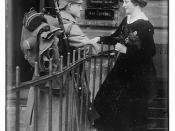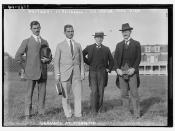The Haber process was developed by two men; a German scientist called Fritz Haber and a French chemist called Henri Le Chatelier. The Haber process is when a reversible reaction between nitrogen and hydrogen forming ammonia.
Ammonia is a colourless gas with a very strong odour. It is made of three atoms of hydrogen and one atom of nitrogen binding together. Ammonia is widely used. It is used in many products as it liquefies easily and when heated into gas absorbs a lot of heat. So it is used in refrigerators. Ammonia that is used in the house is called "Household Ammonia." It is diluted with water and is used for cleaning and washing. Ammonia is also used for making dyes and nylon.
More and more food is needed to feed the ever increasing population. Farmers need to speed up the food production with artificial fertilizers. Ammonia is used to manufacture fertilizers.
The ammonia acidifies the soil and brings out elements that can speed up the process of growing food. The acidifying only lasts for a short duration. Many farmers need ammonia and a lot of it needs to be produced.
There are ways to produce higher amounts of ammonia. For example, Ammonia amounts can be increased during the Haber process by enhancing the pressure during the reaction. When pressure is increased the reaction will try and oppose the change, and to reduce the number of molecules, more ammonia will get formed. The reaction in equilibrium opposes the change; this is part of the Le Chatelier Principle. "When a reversible reaction is in equilibrium and you make a change, it will do what it can to oppose that change."
The process for producing more amount of ammonia. The steps for this are:
* Binding the nitrogen and hydrogen together.


![[German vehicle tax registration issued to George Grantham Bain] (LOC)](https://s.writework.com/uploads/6/60390/german-vehicle-tax-registration-issued-george-grantham-bain-thumb.jpg)